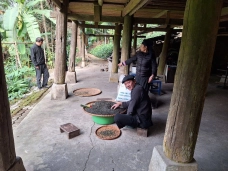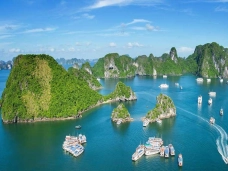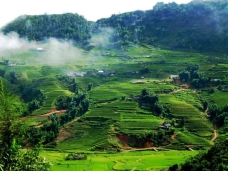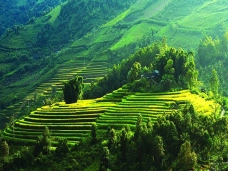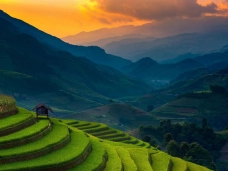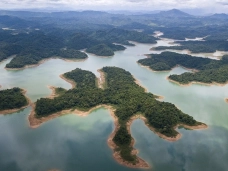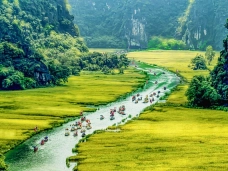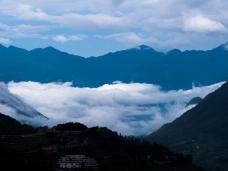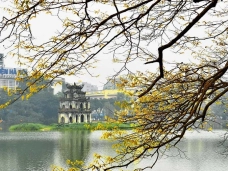Định Hóa Safe Zone – The Hidden Capital of Vietnam’s Resistance
25-03-2025 15:29
Main contents
Location
Highlight Image
General Introduction
The Định Hóa Safe Zone (ATK Định Hóa) is located in Định Hóa District, Thái Nguyên Province – a midland region in the northwest of the province, bordering Tuyên Quang and Bắc Kạn. The district covers nearly 520 km², with a landscape primarily consisting of hills and mountains interspersed with small valleys, streams, old-growth forests, and natural caves. It is a land where “mountains meet mountains, forests connect with forests” – ideal for concealment and well-suited for protracted resistance.
The region is rich in natural resources: diverse forest vegetation with many valuable timber species, abundant freshwater from streams such as Khuôn Tát and Mỏ Gà, and a temperate climate all year round. The terrain and forests here not only enabled survival during wartime but also provided natural protection against enemy detection and pursuit.
The local population primarily comprises ethnic minorities including the Tày, Nùng, Dao, and Sán Chay, who live harmoniously and are steeped in revolutionary traditions. They played vital roles in sheltering cadres, serving as couriers, and transporting supplies—contributing significantly to building a strong rear base.
Shortly after the national resistance broke out in late 1946, the Party Central Committee identified the need for a secure location to serve as the headquarters of the revolution. President Hồ Chí Minh and the Politburo chose Định Hóa as the centre of the Safe Zone. As documented in historical sources such as “The Unforgettable Years” (National Political Publishing House), “Định Hóa was chosen for its rugged terrain, flexible transportation, proximity to key battlefields, and its ability to remain concealed from the enemy.”
“Choosing mountainous forests for a resistance base was a wise strategy and in tune with the people’s will—because it is the people who are the most steadfast guardians of the revolution.”
– President Hồ Chí Minh during a meeting at the Safe Zone (1947), according to records from the Office of the President.
Serving as the “Capital of the Resistance” for nine years (1947–1954), ATK Định Hóa was the birthplace of numerous strategic decisions that led to the historic victory at Điện Biên Phủ, ending French colonial rule in Vietnam.
The Safe Zone through the Years
Before 1945 – A Revolutionary Seedbed
Between 1936 and 1945, many Việt Minh cadres operated in the Định Hóa region. The local people were early supporters of the revolution, actively sheltering cadres and forming Party cells and patriotic associations. Định Hóa was one of the first areas liberated before the August Revolution in 1945, becoming a forward base for the revolution in the Việt Bắc war zone.
1947–1954 – The Capital of Resistance
On 20 March 1947, President Hồ Chí Minh left Hanoi for Định Hóa. He lived and worked in locations such as Khuôn Tát (Phú Đình commune) and Khau Tý (Điềm Mặc commune). Around the same time, central government bodies—including the Office of the President, the Government, the Ministry of Defence, the Voice of Vietnam Radio, the Truth newspaper, and the Department of Propaganda—were relocated to this area.
Significant conferences held in Định Hóa include:
-
The 6th Central Committee Plenum (January 1950) – on preparing forces for strategic offensives.
-
The January 1954 Politburo Conference – planning the Điện Biên Phủ Campaign.
Decisions made in the Safe Zone marked historical turning points that led to victory against the French.
A Living Archive of History
Today, the ATK Định Hóa complex includes over 130 historical sites, among which the core area has been recognised as a Special National Monument by the Prime Minister’s Decision No. 548/QĐ-TTg, dated 10 May 2012.
Highlighted Sites:
-
President Hồ Chí Minh’s Residence at Khuôn Tát: A humble stilt house amid the forest, with a thatched roof and earthen floor, furnished with bamboo. Here, he wrote articles, letters, and directives for national resistance.
-
Cao Cannon Hill: Home to the first Voice of Vietnam Radio station during the resistance, broadcasting war news and patriotic spirit across the country.
-
Bòng Cave (Điềm Mặc Commune): Headquarters of the Ministry of Defence, where General Võ Nguyên Giáp worked during key phases.
-
Khau Tý Hill: President Hồ Chí Minh’s initial residence in the Safe Zone, still preserving the original well, garden, and house foundation.
“Every inch of land in the Safe Zone is imprinted with revolutionary footsteps; every site is a vivid testament to the people’s resilience and unwavering spirit.”
– Prof. Phan Huy Lê, historian.
Cultural and Artistic Expression – The Spirit of Resistance
The Safe Zone was not only a political-military hub but also a cultural cradle where revolutionary art flourished—expressed in poetry, music, and prose. Many artists lived, fought, and composed in the Việt Bắc forest, drawing endless inspiration from the people and the resistance life.
“Việt Bắc” – Poem by Tố Hữu (1954)
More than a farewell poem, Việt Bắc is an epic blend of emotion and combat spirit. Written after the victory at Điện Biên Phủ, it captures the dialogue between a revolutionary cadre and the Việt Bắc people.
“When you return, will you remember me
Fifteen years of love, passionate and deep.
When you return, will you still recall—
The trees, the hills, the rivers, the roots…”
“The roads of Việt Bắc at night
Echoed like the earth itself was shaking.
Troops marched in countless lines
Starry light glinting on bamboo helmets.”
“Guerrillas of the Thao River” – Song by Đỗ Nhuận (1949)
Inspired by folk melodies, this song celebrates the bravery of midland fighters:
“If you return to the Thao River, remember the guerrillas…
Fighting day and night through floodwaters.
Beneath the village banyan tree, unshaken by bombs—
Shouldering rifles, rowing oars, defending our land!”
“The Eyes” – Short story by Nam Cao (1953)
Written in the Safe Zone before the author’s death en route to the South, The Eyes marked a turning point in revolutionary literature—from individual awareness to historical consciousness. Through the eyes of Hoàng, a city intellectual, it portrays his awakening as he immerses in rural life.
“I realised one thing: You cannot look at the revolution with the condescension or pity of an outsider. You must live it, suffer with it, rejoice with the people.”
“Across the Đuống River” – Poem by Hoàng Cầm (1948)
Though not written in Định Hóa, this poetic lament over the destruction of Kinh Bắc remains emblematic of the resistance spirit:
“Why so sad, my dear?
Let me take you back to the Đuống River.
Once, the white sand stretched smooth—
The Đuống flows, shimmering…”
Visiting the Safe Zone – A Journey through History and Nature
ATK Định Hóa is more than a historical site; it is a cultural and eco-tourism destination:
-
Khuôn Tát and Khau Tý Sites: Combine hiking with historical storytelling and memorial rituals.
-
ATK Định Hóa Museum: Displays hundreds of wartime artefacts and photos.
-
Phượng Hoàng Cave and Mỏ Gà Stream: Natural wonders offering relaxation and geographical discovery.
-
Palm Hill, Football Field, Nà Nưa Hut: Sites of revolutionary cultural and sports activities.
Visitors can also enjoy highland markets, sample Tày and Nùng cuisine, or join traditional festivals like the Springtime Lồng Tồng Festival.
Legacy of ATK Định Hóa
More than just a geographical location, ATK Định Hóa stands as a symbol of Vietnamese courage and intellect during the anti-colonial resistance. Each site here is a living page of history, reminding us of a glorious yet humble past—harsh yet proud. A visit to Định Hóa not only reconnects us with history but rekindles patriotism, pride, and faith in the enduring strength of the Vietnamese spirit.
Phong Nha Việt
Similar destination
14-04-2024
Hạ Long - A World Natural Heritage
22-03-2024
Moc Chau, Son La Province
22-03-2024
Mai châu - Hòa Bình
22-03-2024
Dien Bien - History and Culture
22-03-2024
Thanh Hóa Province – Culture and History
22-03-2024
Ninh Bình – History and Culture
22-03-2024
Sapa - People and Nature
22-03-2024







